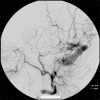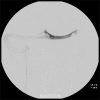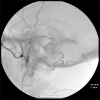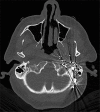Facial palsy after embolization of dural arteriovenous fistula: A case report and literature review
- PMID: 29204306
- PMCID: PMC5691552
- DOI: 10.4103/sni.sni_428_16
Facial palsy after embolization of dural arteriovenous fistula: A case report and literature review
Abstract
Background: Dural arteriovenous fistulas (DAVF) are unusual intracranial vascular malformations consisting of anomalous connections between meningeal arteries and dural sinuses or the veins that pass through them. They have variable clinical presentation and prognosis, which depend on their location and venous hemodynamics. Treatment is based on the closure of the abnormal connections, which is usually conducted via arterial and/or transvenous endovascular techniques.
Case description: We present a male patient who complained of headaches and left-sided pulsatile tinnitus due to DAVF from the external carotid artery branches draining directly into the ipsilateral sigmoid sinus. Embolization with Onyx® was successful, obtaining angiographic occlusion and symptom remission. However, on postoperative day 4, the patient presented with left facial palsy and spontaneous regression.
Conclusion: Although embolization is an effective and safe procedure, complications may occur. Reflux of the embolic agent to the vasa nervorum of the cranial nerve may lead to ischemic neuropathy. Here, we reported a case of embolized DAVF presenting with a postoperative peripheral facial palsy where the two embolized pedicles were branches of the middle meningeal and occipital arteries involved in the vascularization of the extratemporal segment of the facial nerve. We discuss the etiopathogenic, anatomical, and pathophysiological aspects of this complication.
Keywords: Arteriovenous fistula; central nervous system vascular malformations; facial paralysis; intracranial arteriovenous malformations; therapeutic embolization; vasa nervorum.
Conflict of interest statement
There are no conflicts of interest.
Figures








Similar articles
-
Transvenous embolization with a combination of detachable coils and Onyx for a complicated cavernous dural arteriovenous fistula.Chin Med J (Engl). 2008 Sep 5;121(17):1651-5. Chin Med J (Engl). 2008. PMID: 19024093
-
[Peripheral facial palsy after embolization of a dural arteriovenous fistula with Onyx®].HNO. 2011 May;59(5):465-9. doi: 10.1007/s00106-011-2297-9. HNO. 2011. PMID: 21505930 German.
-
Long-term angiographic results of endovascularly "cured" intracranial dural arteriovenous fistulas.J Neurosurg. 2016 Apr;124(4):1123-7. doi: 10.3171/2015.3.JNS1558. Epub 2015 Sep 25. J Neurosurg. 2016. PMID: 26406789
-
Endovascular Recanalization of Occluded Dural Sinus in Patient with Dural Arteriovenous Fistulas: Case Report and Literature Review.World Neurosurg. 2018 Jun;114:269-273. doi: 10.1016/j.wneu.2018.03.140. Epub 2018 Mar 27. World Neurosurg. 2018. PMID: 29602009 Review.
-
First line direct access for transarterial embolization of a dural arteriovenous fistula: Case report and literature review.J Clin Neurosci. 2018 Feb;48:214-217. doi: 10.1016/j.jocn.2017.10.070. Epub 2017 Nov 11. J Clin Neurosci. 2018. PMID: 29137915 Review.
Cited by
-
A case report of multiple cervical artery dissection after peripheral type facial palsy and use of steroids.BMC Neurol. 2018 May 28;18(1):74. doi: 10.1186/s12883-018-1080-x. BMC Neurol. 2018. PMID: 29807531 Free PMC article.
-
Facial nerve palsy after middle meningeal artery embolization for chronic subdural hematoma: a case report.Acta Neurochir (Wien). 2024 Jul 31;166(1):312. doi: 10.1007/s00701-024-06201-z. Acta Neurochir (Wien). 2024. PMID: 39085704
-
Utilizing the Ascending Pharyngeal Artery for Onyx Embolization in Cranial Dural Arteriovenous Fistulas : A Retrospective Analysis.J Korean Neurosurg Soc. 2025 Jul;68(4):415-424. doi: 10.3340/jkns.2024.0168. Epub 2025 Apr 28. J Korean Neurosurg Soc. 2025. PMID: 40289741 Free PMC article.
-
Diplopia after middle meningeal artery embolization for chronic subdural hematoma: A case report.World J Clin Cases. 2025 Aug 16;13(23):106329. doi: 10.12998/wjcc.v13.i23.106329. World J Clin Cases. 2025. PMID: 40821405 Free PMC article.
-
The etiology of Bell's palsy: a review.J Neurol. 2020 Jul;267(7):1896-1905. doi: 10.1007/s00415-019-09282-4. Epub 2019 Mar 28. J Neurol. 2020. PMID: 30923934 Free PMC article. Review.
References
-
- Gaynor BG, Elhammady MS, Jethanamest D, Angeli SI, Aziz-Sultan MA. Incidence of cranial nerve palsy after preoperative embolization of glomus jugulare tumors using Onyx. J Neurosurg. 2014;120:377–81. - PubMed
-
- Kupfer TJ, Aumann K, Laszig R, Meckel S. Periphere Fazialisparese nach Onyx®-Embolisation einer duralen arteriovenösen Fistel. HNO. 2011;59:465–9. - PubMed
-
- Ozanne A, Pereira V, Krings T, Toulgoat F, Lasjaunias P. Arterial vascularization of the cranial nerves. Neuroimaging Clin N Am. 2008;18:431–9. - PubMed
Publication types
LinkOut - more resources
Full Text Sources
Other Literature Sources
